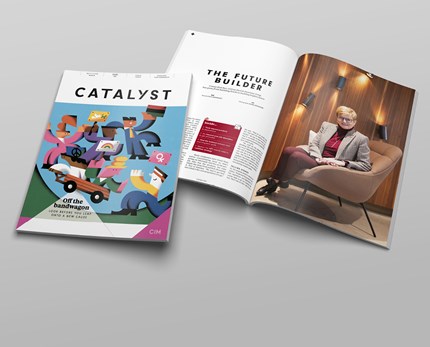How can financial services marketers achieve the right balance between brand and demand?

- 15 June 2023
On 18 April 2023, CIM held our inaugural Financial Services Summit in Canary Wharf, London. The event was filled with insights from and for leaders in the financial sector. Here we’ll dive into the popular ‘brand and demand’ session to explain how financial services marketers can balance ROI and drive brand growth.
At the Financial Service Summit, CIM was joined by Patrick Burton – head of marketing and communications EMEA at JP Morgan, Pauline Bush – head of marketing and communications with Lombard Odier, Tony Jarvis – global MD and co-founder of El Advisory, and Harriet Rosewell – senior director and head of fixed income, equities, FX and crypto product marketing at CME Group.
Read on for their views on brand excellence, demand marketing, societal issues' impact on a central marketing budget, and what you can learn and implement from them.
The challenges of brand ‘vs’ demand
Short-term vs long-term marketing has been a topic of discussion for years but, as Google and its display advertising/PPC models gain an even larger foothold in our marketing budgets, the debate has begun to rage. Senior stakeholders want to see results fast and now, while those same stakeholders in the future will wonder why ROI hasn’t markedly improved over the past 5 years.
But as Tony Jarvis said on the day, “it’s not brand versus demand. It’s a successful combination of both”.
“The pendulum has swung quite significantly into building demand,” said Pauline Bush. “How quickly can you generate the leads and demonstrate a crystal-clear ROI on a day-to-day basis? The hardest challenge has been feeding that up into senior stakeholders.”
Demand is generally easy to demonstrate – marketers need only show the number of leads, or better yet sales, from a proven marketing activity and they can calculate and show an ROI or ROMI. The ratio is widely respected in the boardroom.
Brand, on the other hand, is a much softer science. Continual monitoring of customer sentiment and audience awareness is vital to the modern FS marketer. Marketing teams must remember that you can’t accurately highlight a brand’s power with a single data point.
Presenting your case
“The problem facing marketing is quite often that we assume the head of trading, or whatever function it is, is a marketing expert” added Patrick Burton. “Marketers need to position themselves as the expert and inform leadership [of] the best course of action in a language they understand.”
One of the key challenges in successfully balancing brand and demand is the research or evidence required to develop an accurate ratio. Multiple different datasets are often required to ensure an accurate analysis of which factor - brand or demand - is driving growth.
“Our crypto product portfolio provides an excellent example of this", said Harriet Rosewell. “Taking these products to market obviously had the potential to introduce reputational risk and could also have proven to be a damp squib if we didn’t take into consideration our activities compared to those of our competition."
In short, marketers just need to do more preparation. When Harriet’s marketing team took their crypto product portfolio to market, they analysed the competition, the rival product suites, how much competitors were spending on ad space and which particular markets they were going after.
“We put it all on paper, all the different personas: whether it’s a retail trader, whether it was an institutional trader [etc]. We Looked at the pipeline of sales conversations to see which kind of institution might be the first to move and this was instrumental in making our case that we needed to do something differently.”
“We took our Board on a journey with us and as a result demand and brand landed at the same time, and the same place with the same goal, using the key tenet of our brand.”
Even with all of that work, measuring brand in a B2B space is a challenge. Larger sales volumes and a smaller number of customers and fewer available markets means that those studies of salience are pulling from a much smaller pool.
Rosewell believes the answer to this conundrum lies in the ability of marketers to establish credibility. “I think a lot of it comes down to the people being trusted to be good stewards of product, that then build brand confidence.”
Demonstrating value and bringing marketing in-house
Marketing within the financial services sector creates a hyper-focused lens on ‘value’. One of the systemic issues this creates is the perception that one area of the business is responsible for bringing in all the revenue, and this can lead to the false perception that these particular areas of the business don’t need marketing.
Roswell continued, “You see this kind of mentality in many organisations. And we almost didn’t know how to change that. But we knew we needed to build it out, and we did something which many organisations have – we built out what is essentially an in-house agency”.
Bringing marketing in-house increases the level of creative control the organisation has and can also vastly reduce the communication time within projects. Whilst this may result in the loss of some of the expertise that agencies have access to, well-placed savvy investment in talent and people can reap dividends.
Dedicated social media managers and content creators amongst others can send your audience engagement soaring. But going beyond the surface, they can also be an invaluable tool for demonstrating the impact of marketing. These team members can then use that content to demonstrate a sales funnel that started long before the investment banker or sales exec picked up the phone.
However, you need to be intelligent with your targeting or you can end up engaging those who aren’t looking to invest or buy.
Key to success is intelligent targeting. “Over the last five years, we’ve got great traction and great engagement from people. I think the reason we’re coming back to demand is: on the brand side, we’ve realised we’ve been kidding ourselves for a little bit too long. We’ve discovered that a lot of the people engaging with us, were really just wanting a job.”
How has post-pandemic changed financial marketing and the relationship with sales?
The loss, and now slow regrowth of face-to-face events hit both marketing and sales hard during the pandemic and the effects have lingered on. From multi-contact marketing days (like the CIM Financial Services Summit) to on-site sales pitches, several crucial lifelines were cut and internal relationships became strained by going exclusively digital.
Events can benefit both marketing and sales, from the content generated on the day to the networking and information sharing that sales is built on. But it all comes down to the money invested, and the money earned. It’s essential to embed sales into the events process so that key information is registered as having come from the event.
“We’ve had this golden age of digital ad campaigns,” said Rosewell. “We’re spending so much time really assessing those events now – not to say they’re wrong, but we can prove our end on digital. Now let’s prove it on events”.
It is possible to track event ROI, but it needs buy-in from marketing and sales to gather the data and follow the trail. Brand from Marketing and demand from Sales. Sell what you need, and why you need it, to the Sales team and they’ll be happy to contribute to the cause.
What does excellence look like?
In short: Netflix.
While it might feel hard to compare a streaming service to the financial services sector, it’s less the product than the service that Netflix can teach us about argues Bush. According to Statista (households in UK vs Netflix subscribers), 61% of households in the UK had a Netflix subscription as of Q4 2022 – which equates to 17.15 million users.
17.15 million users: accessing personalised content, being served ads for other content published by Netflix (with a handful being served 3rd party ads for a £3 reduction in subscription fee), providing data on how to improve the service, and being available for customer feedback. By creating a platform that customers and clients have a reason to use, you’ve ensured that you have got access to continually valuable marketing data.
“We’re big enough that, certainly on the trading side, customers are actually logging into JP Morgan. Which opens up an entirely new thing: personalisation, which is a bit of a holy grail[...] We understand the behaviour of people so much our demand campaigns have gotten better” said Burton.
The pitfalls in building demand
“You have to be better at planning. And you have to be self-critical”, said Burton. “The one saving grace about the way we budget, which I actually resent half the time, is that you do have to go and ask people who run businesses to give you the money. But that’s actually a very healthy way to think about things. They should say how much, and why?”
One of the greatest pitfalls of building demand, particularly with direct ads and especially when it’s the business' sole focus, is over-reliance. Failure to capture customers through following up with them or through brand work, can result in the business having to pay to acquire the same customer twice.
It’s also important to understand the customer’s mindset, to be conscious of their barriers to entry. What will prevent your customers from wanting to trade, and how can you assuage those fears in your marketing? If there are barriers that cannot be overcome by certain members of your audience, don’t try and sell to them as they are unlikely to be persuaded otherwise.
“We don’t try to do everything. We don’t try and win in products where it’s a very close community of traders or the product is quite expensive or it’s just been shelved”, said Rosewell.
“At some point when the market conditions determine it might be relevant, we try and pick up the things that we think are liquid that will enhance the brand. When we perceive the community is large enough for us to develop and find quality leads for, and that we have advocates in the business who want to partner with us.”
Brand or demand?
As you’ll read time and time again: though the pendulum might occasionally swing one way or the other, successful marketing has to be a blend of both brand and demand. Demand will always see short-term gains, but you’ll pay again and again to see those gains each year whether it’s the investment team or your own that claims the victory.
Similarly, brand work is a slow, slow burn which reaps rewards in two or ten years’ time. Savvy marketers will work out how to effectively combine these two essential aspects. Pairing smart, targeted demand work with a well-thought-out brand campaign will prove to be the most effective method of ensuring growth.
CIM members can join CIM's Financial Services group on LinkedIn today to stay up-to-date with the latest news and information from the sector. Not yet a CIM member? Sign up today to gain access to all the benefits of CIM membership and join our Financial Services Sector Interest Group.

- 0 views

 FAQs
FAQs
 Log in
Log in
 MyCIM
MyCIM






